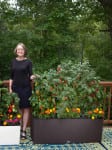Amazing Vegetables in HUGE Containers (Video, 4:07)
By Pamela Crawford
Large vegetables, like tomatoes, like really large pots. See what container garden guru Pamela Crawford did to grow amazing vegetables in huge containers in this quick video.
Here are some of Pamela’s vegetable growing tips from her book, ‘Easy Container Combos: Vegetables and Flowers.”
Eight Easy Ways to Kill Vegetables and Flowers
1. Buy the Wrong Plants.
Most beginners buy plants that don’t meet their expectations simply because they don’t understand the plant’s flowering habits – or the plant is an erratic performer.
Take this book with you to your garden center. Look up the flowers and vegetables in the index, and read about them prior to buying the plants. ‘Easy Container Gardens’ is a good choice to take with you as well. More flowers are referenced in that book.
You need to know how large a vegetable plant gets, how easy it is to grow in containers, when to plant it, and how many vegetables it will produce prior to buying it. The last chapter of this book includes this information.
2. Buy the Wrong Potting Mix.
Don’t skimp on your potting mix. Good potting mix costs a little bit more, but makes all the difference. Plants grow larger and live longer with quality potting mix. Do not buy topsoil, garden soil, or potting soil for containers. It is too heavy, and the plants may rot and die quickly.
Look for a brand name you trust. Peters, Miracle Grow, Lambert’s, and Fafard (along with many others) offer top-quality, potting mix.
3. Buy the Wrong Fertilizer.
I have killed plants with fertilizers several times. However, plants need nutrients, and fertilizer is an easy way to provide them. It hasn’t been easy to choose the right one.
After years of mistakes and unhealthy plants, I discovered the fertilizer on page 36. It worked so well, without destroying anything in the process, that I put my name on it (available from kinsmangarden.com)!
4. Plant in the Wrong Season.
Vegetables either like it warm or cool. Cabbages (right), for example, are cool-season vegetables, and if you plant them in the wrong season, they will not do well. I made this mistake several times and lost quite a few plants because of it.
See page 22 for listings of warm- and cool-season vegetables. The last chapter of this book gives much more detail about each vegetable.
5. Water Incorrectly.
Like people, plants need water to live. However, if you give them too much, they drown and die. If you give them too little, they die of thirst.
Luckily, knowing when and how much to water is quite easy. See pages 38 to 40 for this information.
Most vegetables need a lot of water, but you can drown them just the same. Look for signs of wilting, or dry potting mix, before watering.
6. Pile Potting Mix around the Stem of the Plant.
If potting mix or organic mulch comes into contact with the stem of many plants, the stem can rot, killing the plant (except for tomatoes). It is quite easy to avoid this plight by simply planting the plants a little a bit higher, as shown in the drawing.
To help retain water, some people like to put organic mulch on top of the potting mix after they have planted a container. This method works fine on large plants, like azaleas or ti plants, provided you don’t pile the mulch up around the stem. However, on small plants, like impatiens or lettuce, it is quite difficult to mulch without harming the plant.
7. Plant in a Pot without Holes in the Bottom.
If your pots don’t have holes in the bottom for drainage, the plants will die (unless the pot is specially designed for self watering). See page 29 to learn how to drill holes in the bottom of pots.
Luckily, most pots come with holes in the bottom. If you see one you want to buy that doesn’t have holes, ask the salesperson if he/she will drill them for you. Many garden centers offer that service.
8. Give the Plant the Wrong Amount of Light.
Different plants need different amounts of light. A tomato (shown) likes sun, while lettuce takes more shade. But, how much sun is enough for sun plants? The rule of thumb is a minimum of six hours of direct sun every day. In other words, if your tomato just gets two hours of sun, with shade the rest of the day, it will not do well.
Most vegetables need a full six hours of sun per day. If they get less than that, they will not perform well. However, some cool-season, leafy vegetables (arugula, kale, lettuce, mustard greens, spinach, and Swiss chard) can get by with partial shade. See pages 24 to 25 as well as the individual plant profiles in the last chapter of this book for more specifics.
Pamela Crawford designs gardens in Palm Beach County, Florida. This video is appropriate throughout Pamela’s service area, including Boca Raton landscapes, town of Palm Beach landscapes, Palm Beach Gardens landscapes, Jupiter landscapes, and Wellington landscapes.
This article is taken from ‘Easy Container Combos, Vegetables & Flowers’ by Pamela Crawford, Copyright ©2010, Color Garden, Inc.
All rights reserved. No part of this publication may be reproduced or transmitted in any form or by any means, electronic or mechanical, including photocopy, recording, or any other information storage and retrieval system (including anywhere on the web) without prior permission in writing from the publisher.
Published by Color Garden, Inc.,





